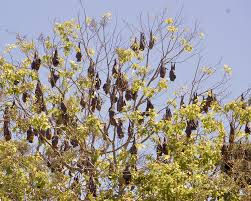Without Them, Entire Ecosystems will Collapse.
The Flying foxes or Pteropus (scientific name) are not only intelligent, remarkable and unique but help regenerate our forests and keep ecosystems healthy through pollination and seed dispersal. They are a migratory, nomadic "keystone" species, which means that many other species of plants and animals rely upon them for their survival and wellbeing. Like the bees, flying foxes help drive biodiversity and yet, sadly, are faced with a number of threats. These include climate change, large-scale land clearing and other human-caused ecological pressures. It’s extremely important we address these issues; we need them more than ever.

Baby Flying Fox - Animals Australia
Flying foxes fall in the category of "bats" - more accurately megabats (big bats) compared to the microbats (small bats). Commonly they are also called fruit bats, but their diet is predominantly nectar, pollen and alternatively fruit, if their main food source is not available. Flying foxes use their eyes and ears for orientation as we do, unlike the smaller species, the insect-eating microbats, who use sonar for direction.
“They are flying gardeners performing a priceless environmental service” - Peter Cundall,
ABC's Gardening Australia
📽 National Geographic watch: (2:20)
Some more facts about bats in a nutshell:
Bats are the only mammals capable of sustained flight.
Bats are a very important pollinator of native plants and disperse seeds over a wide area.
There are about 1100 species of bats in the world. Australia has 77 different species of bats. South-east Queensland has at least 31 different species.
The smallest bat in the world is the Bumblebee Bat which lives in Thailand and weighs only 2 grams.
The largest bat in the world is the Giant Flying Fox which lives in India and has a wingspan of 1.8 metres.
Bats are eutherian mammals and like humans they carry the foetus in the uterus until it is well developed.
Bats cannot stand on their hind legs, they can only hang by their feet and by their thumbs.

Australian black flying fox - Gizmodo.com.au
Flying foxes live together in large colonies and fly out every night in search of food. Native flowering eucalypts are the natural food source and these trees will be visited by bats foraging for nectar. They are not just feeding during this time, but performing a crucial role of pollinating native forests and spreading seeds to ensure the longevity of our bush.

Flying fox colony - Wikipedia Common

Colony flying out - Pixneo.com
“Flying foxes are foresters keeping the ecosystem together. If we are to keep the remnants of our forests healthy, we need the flying foxes. The two are inseparable. “ - Dr Nicki Markus, Chief Conservation Office of Bush Heritage Australia

Grey headed flying fox - NSW National Parks, NSW Government (Australia)
Unfortunately, as natural habitat and food sources shrink through human activities, many flying fox roosts are becoming surrounded by urban areas and it is here that they encounter one of the biggest threats to their welfare and survival.
The major threats to the survival of the flying foxes include habitat loss (land clearing), camp disturbance, starvation, increased heat events, legal and illegal shooting, and man-made hazards like power lines, barbed wire and backyard fruit tree netting.
“Grey-headed flying foxes are exposed to several threats, including loss of foraging and roosting habitat, competition with the black flying fox, and mass die-offs caused by extreme temperature events. When present in urban environments, grey-headed flying foxes are sometimes perceived as a nuisance. Cultivated orchard fruits are also taken, but apparently only at times when other food items are scarce. Because their roosting and foraging habits bring the species into conflict with humans, they suffer from direct killing of animals in orchards and harassment and destruction of roosts. Negative public perception of the species has intensified with the discovery of three recently emerged zoonotic viruses that are potentially fatal to humans: Hendra virus, Australian bat lyssavirus and Menangle virus. However, only Australian bat lyssavirus is known from two isolated cases to be directly transmissible from bats to humans. No person has ever died from ABLV (Lyssavirus) after having had the ABLV post-exposure vaccine. Unsuitable backyard fruit tree netting also kills many animals and may bring them into close contact with humans, but can be avoided by using wildlife-safe netting. Barbed wire may also lead to casualties; this can be ameliorated by removing old or unnecessary barbed wire or marking it with bright paint.” (https://en.wikipedia.org/wiki/Grey-headed_flying_fox)
Following are a few of the many organisations in Australia - mostly funded by public donations - who care for injured or stressed bats, where many compassionate volunteers put endless hours into helping these special animals.
Please - if you see/find a bat in distress - do not touch but call one of the wildlife rescue organisations. Thank you for the interest in another blog of our series “Did you know…”
Bat Rescue Inc. (Brisbane and Sunshine Coast, Queensland)
Bats Queensland
Australian Bat Clinic
RSPCA Queensland
🦇 References
Wildcare Australia, South East Queensland, 2013 (viewed 01.03.2018)
Wikipedia, 2018 (viewed 01.03.2018)

Comments